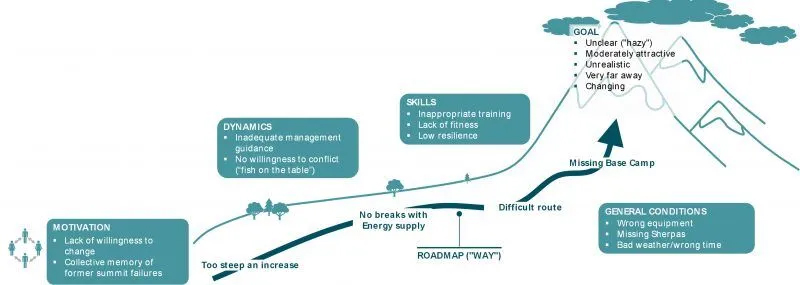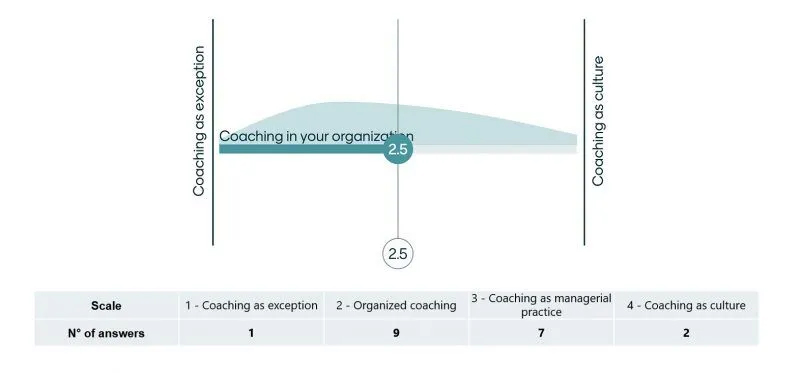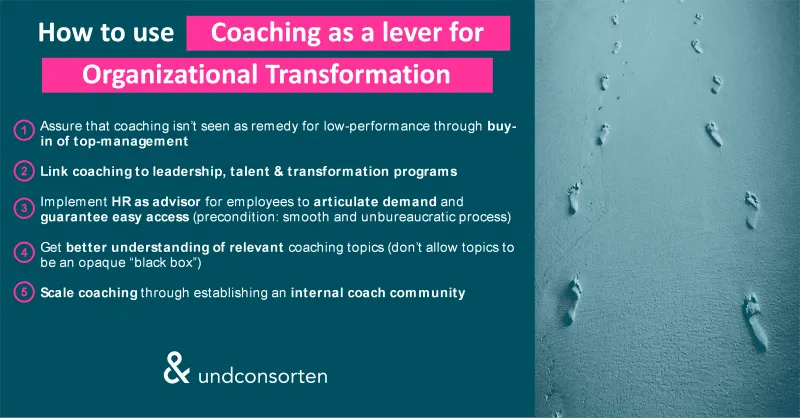
How to use coaching as lever for organizational transformation
After its beginnings in the 1990s, coaching is now an established instrument of personnel development in many organizations. The coaching market currently has a global turnover of approx. 2.8 billion € and has been growing with rates of up to approx. 40 %.i Also during the pandemic, the importance of coaching in personnel development continues to grow: 65 % of coaching practitioners worldwide are convinced, that coaching as a whole will emerge stronger from the pandemic.ii
However, our experience shows, that coaching is usually still seen as an individual development measure available only to selected parts of the organization (typically: top executives) and is not used strategically. We are convinced: There is more power in it when linking it to organizational transformation. In this series of blog posts, we will show you why (and how) in three steps:
- Connection between coaching and transformation
- Supporting developments in coaching landscape (aka “coaching trends”)
- Five measures to use coaching in your organization as lever for transformation
A successful transformation relies on success factors which are predestined for coaching
Despite being implemented with great effort, many transformations fail. Whether you believe in the often cited 70 % failure rate of transformationsiii, or not – our experience clearly shows that many organizations struggle in this respect. But why? Let’s think about transformation as a difficult hike in the alps …
Would you even start the hike with an unclear or unrealistic goal? Probably not, right? Also, a poor roadmap (too steep of an increase, no breaks, detours) can ruin your trip. What about your hiking companions? Are you sure they are motivated enough to climb the mountain, and do they have the right skills for this? And, most importantly: Is your guidance as leader of the group adequate? Of course, there might be also disadvantageous general conditions which you cannot affect directly: The weather might be bad or it’s just the wrong timing.
Let’s switch to transformation in your organization: Does our hiking metaphor sound familiar to you with respect to obstacles in your firm?
Anyway, there are some good news: For most of the mentioned aspects, coaching is an effective instrument to address them. “Dealing with uncertainty and change”, “being an inspirational leader” or “finding the right strategic objective”– all those aspects are examples for typical coaching situations recognized in the communityiv.
Specific skills are also “coachable” and, if done so in a structured and strategically oriented format, can be a lever to support transformation. You wonder how? Let’s take our client’s sales organization focused on solution sales and contracting (B2B) as an example, where sales performance needed to improve by > 30 % during the last quarter of their financial year. We engaged multiple levels of the organization at the same time:
- On a team level, we took an agile sales approach – implementing a new performance management and meeting logic – to focus attention on the most relevant leads.
- On a leadership level, we worked with leadership and team coaching, to improve leadership in the newly formed agile setup and to shape a high-performing team.
- On the individual sales rep. level, we delivered sales coaching to the entire sales team (30 sales representatives), working on the individual sales skills and performance. This created an immediate “sales push”, closing the performance gap and exceeding deals closed in the prior months by far.
But most importantly, the broad exposure of our coaches to the organization helped to identify important organizational levers the organization needed to pull on an overarching level (e.g. organizational setup, processes, roles & responsibilities etc.) in order to really transform the sales organization and move it to a new level.
Addressing all organizational levels and combining information on “the frame” in which the people operated (without impairing confidentiality!) was the key to success. We are convinced that this example can be transferred to many other contexts. Broader accessibility of coaching is a prerequisite, as well as scaling of coaching to predefined parts of the organization and, of course, the systematic evaluation of meta-level insights.

Recent developments allow coaching to be scaled within the organization and thus support transformations more easily
Although being recognized as an effective stand-alone measure, coaching is usually not fully integrated into organizations. A survey among participantsv of our recent virtual exchange on coaching revealed that many companies are on their way to establish a broader use of coaching, but still haven’t established “coaching as culture” (see Figure 3). In order to leverage transformation initiatives, the broad use of coaching is a missing piece to tackle obstacles effectively. Fortunately, recent developments pave the way to change: When coaches were asked in 2006 about the purpose of their assignment, it became clear that they were usually hired to solve problems with top executives in exceptional cases. Mostly, coaching was used in case of acute need for rapid external support of individual managers in times of crisis: “coaching as Exception”. vi Nowadays, we observe various companies which are proud to have implemented “coaching as culture” and even use it for employer branding (e.g., SAP, Google)vii. Coaching is a standard in the whole organization (usually available for everyone) and serves as decisive competitive advantage and enabler for agile working. In a “coaching Organization”, coaching is used as a strategic instrument to achieve company goals and values. For example, if a company’s strategic goal is to improve their time-to-market, coaching on uncertainty tolerance might be an adequate instrument to support this goal. But there is not just black and white: Our experience shows that companies usually evolve over a few steps to move from stage 1 to stage 4. The next best move to broaden exposure and acceptance of coaching in your organization is to link coaching to your talent and leadership programs and make it mandatory there (on an individual, team or peer-to-peer level) – Stage 2: Organized coaching. As one of our clients experienced, this can set off snowball effects of people experiencing the use of coaching first-hand and continuing it after the programs end. Changing the play of leadership and enabling leaders to act as coaches for their employees is the next degree (Stage 3: ”Coaching as managerial practice”). In this stage, at least a specific target group – the leaders – get specifically skilled to take on the coaching role and change the way they interact with their teams, thereby opening op rooms for different conversations. Moving beyond this target group and enabling broader parts of the organization to work as coaches internally lastly brings you to Stage 4: “Coaching as a culture” (see Figure 2).


So, what helps us getting there? Recent developments would not have been possible without the following coaching trends, which also pave the way for further strategic use of coaching. We distinguish “market trends”, which refer to the whole coaching market, from “drivers inside the firm”, reflecting a company perspective.
Market Trends
Virtualization
The trend towards using virtual conference tools in coaching is by no means new. In the last 10 years, digital sessions have gained enormously in importance and are now replacing the classic face-to-face setting at the forefront of coaching formats. The cross-industry and international transformation of working methods due to the pandemic on the one hand increases the need for coaching and on the other hand ensures an increased acceptance of digital coaching formats. Portals for digital coaching services are therefore already expanding their capacities to meet the increasing demand. This trend is extremely important as it makes coaching more available and affordable especially in times of COVID-19.viii
Consolidation
Since the job title “coach” is usually not protected, many organizations complain about the lack of transparency in the market. As a result, companies rely on personal recommendations, big providers as well as coaching pools in their companies, leading to an increasing consolidation.ix This trend is supported by online platform operators (e.g., Coachhub, Sharpist) which are added preselectorsx: Although working with individual coaches, it is the platform which selects coaches and appears as provider to the client. Thus, as many other platform businesses, online coaching platforms accelerate the consolidation of the market. Nevertheless, they also decrease market entry barriers as qualified single coaches now do not have to market themselves but can rely on the platform network.xi
Drivers inside the firm
Internalization
Among many companies, we observe that increased investment in internal coaching competencies starts replacing external coaches. But it’s not just the increased availability of coaches at a lower cost. The development of coaches as such enriches the organization and drives it towards a coaching organization. Internal coaching provides the framework for deepening connections across an organization, strengthening internal networks and spreading the impact of coaching, also lowering the attrition risk of coachees.xii
Democratization
Coaching is no longer reserved for top executives but is now carried to the breadth of the organization. In fact, only 1/3 of coaching services are now provided for top executives. The remainder is available to a broader audience along the talent pipeline at all hierarchical levels. The other mentioned trends as well as new formats (e.g. group/team coachings) foster the democratization of coaching in the firm.xiii
Five measures to use coaching in your organization as lever for transformation
How to integrate these insights into your company? The following advice reflects patterns we observe among clients and is a synthesis of our virtually exchange format on coaching in November 2020:

1. Assure that coaching isn’t seen as remedy for low-performance through buy-in of top-management
In many organizations, coaching is still seen as a “treatment“, in case of bad performance. Make sure that there is enough buy-in from top-management to overcome this impression.
First, top management needs to send out clear messages regarding the importance of coaching. Take the example of Microsoft: After becoming CEO in 2014, Satya Nadella started implementing a “growth” mindset at Microsoft narrowed down to three leadership behaviours: “Model”, “coach”, “Care”. With a clear perspective, Satya was able to drive cultural change at Microsoft and multiply the firm’s value.
Second, there must be clarity on the "why" behind the roll-out of a coaching program accompanied through a multi-channel and multi-stakeholder communication. These actions are crucial to secure employee engagement.
2. Link coaching to leadership, talent & transformation programs
Linking coaching to other HRD programs will help you kill two birds with one stone: It will deepen the learning experience and will create broader exposure to coaching for relevant target groups, who otherwise might be sceptical of why to invest time into it. Take the example of a training on “being an inspirational leader”, which is highly relevant in a transformational context and where coaching will be a valuable part of the training journey: After a physical or virtual training, coaching helps the respective manager to reflect leaning goals and implement them in their everyday life. Thus, coaching helps to boost the effectiveness of the training. At the same time, we know from many clients that people who have never been in touch with coaching before, wonder why they should take time to or which topic they could bring to the session. Integrating it with a given topic and process lowers the “entry barrier” and allows direct experience.
3. Implement HR as advisor for employees to articulate demand and guarantee easy access (precondition: smooth and unbureaucratic process)
Despite the importance of a clear coaching topic (see 4.) coachees often struggle to articulate their demand. In this context, your Human Resources department can function as a “trusted advisor”: By helping employees to specify, HR removes the first impediment to guarantee a successful coaching experience. To do so successfully, HR itself needs to undergo some upskilling and take on a clearer coach role – which by the way is the way forward anyway.
Furthermore, a smooth and unbureaucratic process is important to lower the barriers and facilitate access to coaching – which is necessary for the broader application to transform the organization. Building up a transparent coach pool, either through cooperation with (virtual) suppliers or through the installation of an internal coach community, as well as making sure that coaching is evaluated in a systematic manner to continuously improve the process and gain overarching insights, are two of the success factors we recommend keeping in mind for sure (for more, get in touch!).
4. Get better understanding of relevant coaching topics (don’t allow topics to be an opaque “black box”)
In many client companies we noticed that coaching topics generally are very confidential with few data available on them.
There is no doubt that confidentiality and a safe space are crucial for coaching success. Still, we are fully convinced that confidentiality will not be jeopardized by gathering anonymous data on the topics. Moreover, data on coaching topics will help responsible managers to better understand and guide their organization. Only by establishing some kind of transparency, necessary topics for transformation can be addressed adequately and the organization can be moved forward by pulling the right levers.
5. Scale coaching through establishing an internal coach community
A well-working internal coach community is one of the most important steps towards the strategic application of coaching. Based on the snowball-effect, the popularity of coaching will increase exponentially with more and more internal coaches and thus you’ll be able to leverage topics necessary for organizational transformation (e.g. culture of openness to change). A good practice from the corporate world is SAP, with >550 internal coaches present all over the world.xiv
Keep in mind to guarantee high standards regarding the qualification of internal coaches for example through Certifications (e.g., ICF).
So, what are you waiting for? We think that due to the implications of COVID-19 it is actually a very good time to foster coaching in your organization: Take advantage of a favourable frame (e.g. increased digitization, necessity to react to a changing and sometimes unpredictable environment) to leverage transformation in your organisation.
We are more than happy to hear about your experiences and learnings. Do you agree with our findings or does your experience indicate otherwise? Please don’t hesitate to comment on the article and share your opinion with us!
Sources
[i] ICF Global Coaching Study (2020)
[ii] ICF Study (2020): COVID-19 and the Coaching Industry
[iii] Hughes (2011)
[iv] XING Coaches + Trainer (2018), Harvard Business Review (2009), The Manchester Review (2001)
[v] Experts and Managers in charge of coaching and/or transformation from a broad range of companies (usually big global players from all industries) were asked to locate their firm on the scale
[vi] Sherpa (2020)
[vii] ICF (2020); Coaching Magazin (2011)
[viii] Sherpa (2020), Business Punk (2020)
[ix] XING Coaches + Trainer (2018)
[x] Sherpa (2020)
[xi] Business Punk (2020) [xii] Rock, D. and Donde, R. (2008)
[xiii] Sherpa (2020)
[xiv] ICF (2020)




